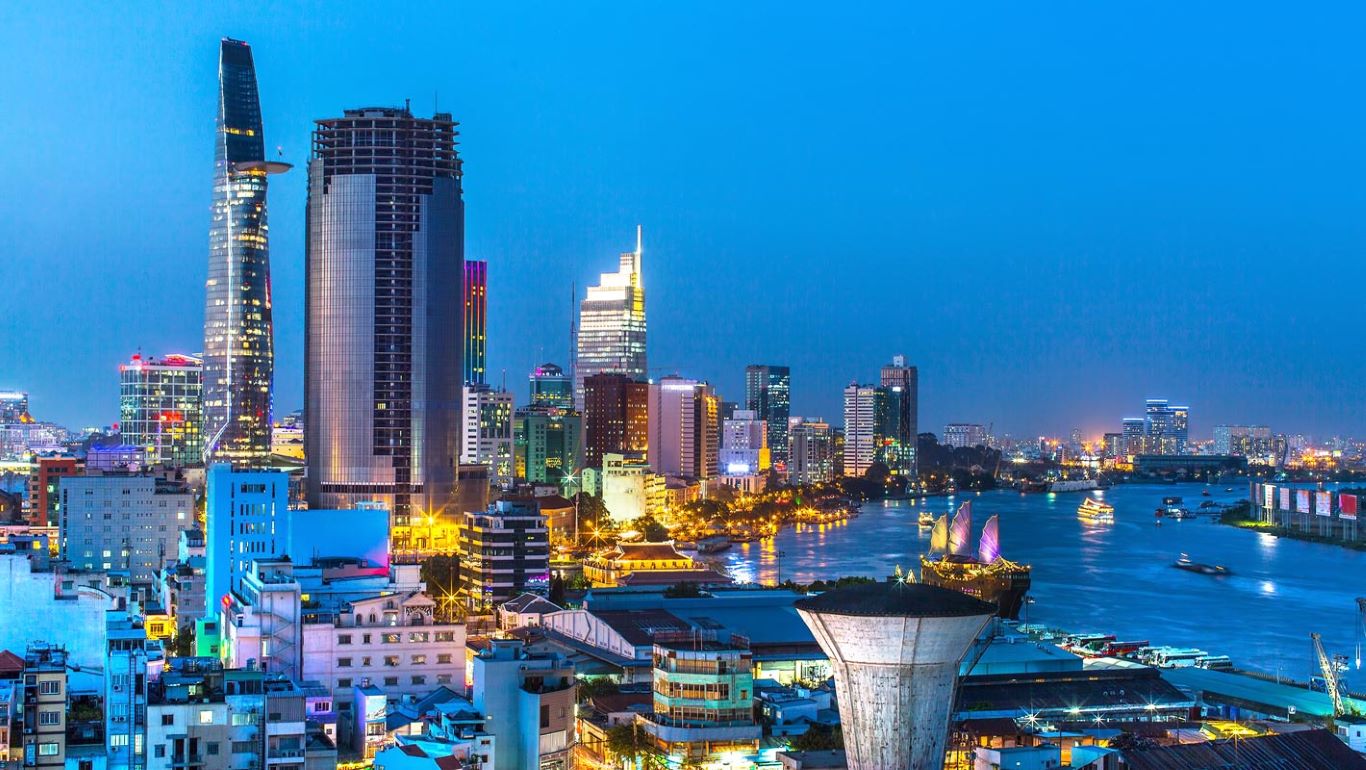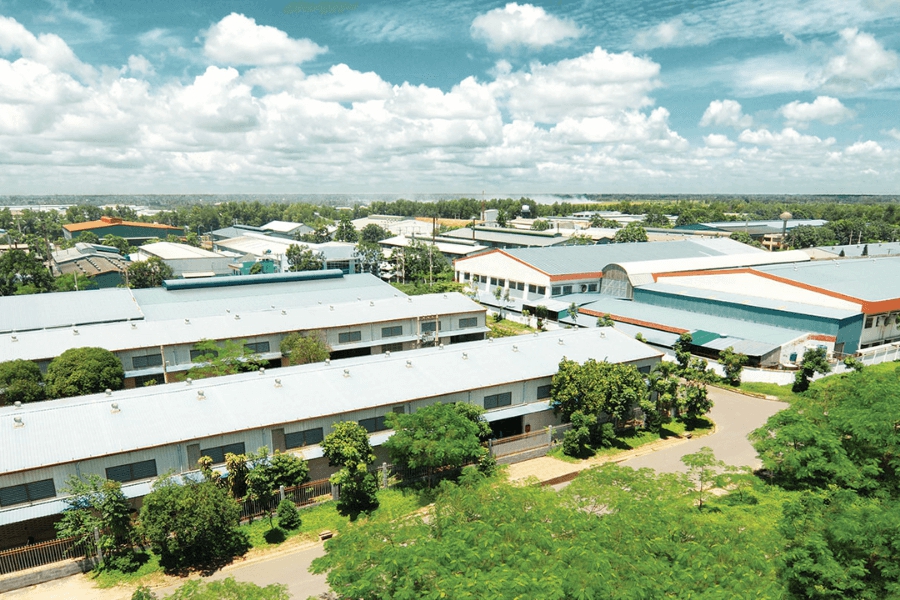The strategic position of Ho Chi Minh City
Ho Chi Minh City is a special urban area, an important gateway connecting the Southeast and the Mekong Delta with the region and the world. The city center is 50 km flying distance from the East Coast. It is a hub of transportation connecting provinces in the region and an international gateway.
Ho Chi Minh City is nearly 1,730 km away from the capital Hanoi by road and is located at the international crossroads of maritime routes from North to South and from East to West. It is the focal point of the Southeast Asia region.
The socio-economic development level of Ho Chi Minh City is the highest in the country and it is the pillar of the national economy, with the ability to compete with other countries in the Southeast Asia and Asia region. The population, labor, land, and large urban system meet the growing needs and aspirations for sustainable development of a future mega city. The economic, technical, and social infrastructure has been and is being invested in a modern and synchronized manner.
The city is the largest banking and financial center in Vietnam, leading the country in terms of the number of banks and financial transactions.

The challenges on the path of development
In the 10-year Socio-Economic Development Strategy 2021-2030, Vietnam aims to promote the development of Ho Chi Minh City into an international financial center. However, this path is not without difficulties and challenges.
According to information from the Workshop on Consultation on Hanoi City Planning for the period 2021-2030, vision to 2050, Minister of Planning and Investment Nguyen Chi Dung said that the potential, strengths, breakthroughs, and creativity of Ho Chi Minh City have not been effectively exploited, not commensurate with the potential, advantages, extraordinary expectations, and leading role in leading and driving the region and the country’s both economics and regions.
In addition, the growth model and economic structure change slowly, the transformation does not keep up with the trends and new development opportunities of the era. The quality and labor productivity of the city’s growth are lower than the national average. The labor force’s general skill level is still low, and the high-income group accounts for only 5%. The non-official labor rate is still high.
The proportion of industry in the economic structure is gradually decreasing; the internal structure of the industry is still backward, relying heavily on the labor-deficient sector, and services mainly rely on commerce, transportation, and high value-added sectors such as finance, health care, education, and tourism which have not played a leading role yet.

An industrial zone in Ho Chi Minh City.
The organization of development space still has many shortcomings, unable to create rapid and sustainable development advantages; many industrial park infrastructures and development spaces are still limited; attracting investment and interlinking within the city, interlinking with other localities in the Southeast region, the Mekong Delta region, and other economic regions of the country are still limited, inefficient; the potential, advantages, and internal strengths of the localities have not been fully exploited. As a result, the leading and spreading of the economic center is not commensurate with the potential, advantages, and expectations. The international gateway advantage of the city will be gradually reduced.
Urban planning and implementation are still limited, the urban space structure is not suitable for a large and future megacity, not fully exploiting the potential and advantages of the riverside and coastal urban areas.
In addition, the urban infrastructure is overloaded compared to the rapid population growth, slow development of urban infrastructure, especially underground infrastructure. Traffic congestion, environmental pollution are increasing, the negative impact of climate change, overloading, high input leads to reduced competitiveness. Interlinking regions are not effective, not fully exploiting the position, leading role, and driving force of the big and leading economic center of the country for localities and surrounding regions. The leading roles, expectations, and advantages have not been commensurate. The decreasing trend of the international gateway advantage of the city.
Economic and social situation in Ho Chi Minh City in January 2024
In January 2024, the total retail sales of goods and consumer service revenue in Ho Chi Minh City reached VND 103,241 billion, an increase of 1.1% compared to the previous month and an increase of 24.4% compared to the same period.
From January 1 – 20, 2024, the city granted permits to establish 3,303 new businesses with a registered capital of VND 39,020 billion, an increase of more than 30% in the number of permits and an increase of more than 117% in capital compared to the same period. Total foreign direct investment (FDI) into the city reached USD 125.7 million, equivalent to more than 70% compared to the same period, of which there were 80 new projects, an increase of 60% compared to the same period, with a registered capital of USD 23.8 million, equivalent to 27.4% compared to the same period.
The industrial production index across the city area increased by 26.9% compared to the same period. The consumer price index (CPI) in the month increased by 0.46% compared to the previous month and increased by 2.76% compared to the same period.
The total import and export turnover of goods increased by 19.8%; estimated total tourism revenue increased by 57.4% compared to the same period.
As of January 12, 2024, the total investment capital from the state budget has been disbursed more than VND 45,865 billion, reaching 67% of the planned capital for 2023 assigned by the city People’s Committee and reaching 65% of the planned capital assigned by the Prime Minister. It is estimated that by the end of January 2024, the disbursed amount will reach over VND 49,417 billion, reaching 72% of the planned capital assigned by the city People’s Committee and reaching 70% of the planned capital assigned by the Prime Minister.
“The city ended the first month of the new year with more positive numbers comparing to the same period, along with the efforts of the entire system, departments, sectors, businesses, hoping that this will be the driving force for the successful implementation of goals and targets in 2024,” Mr. Nguyen Van Dung, Vice Chairman of the HCM City People’s Committee shared at a meeting on the economic and social situation in January, tasks and focal solutions in February 2024.





































